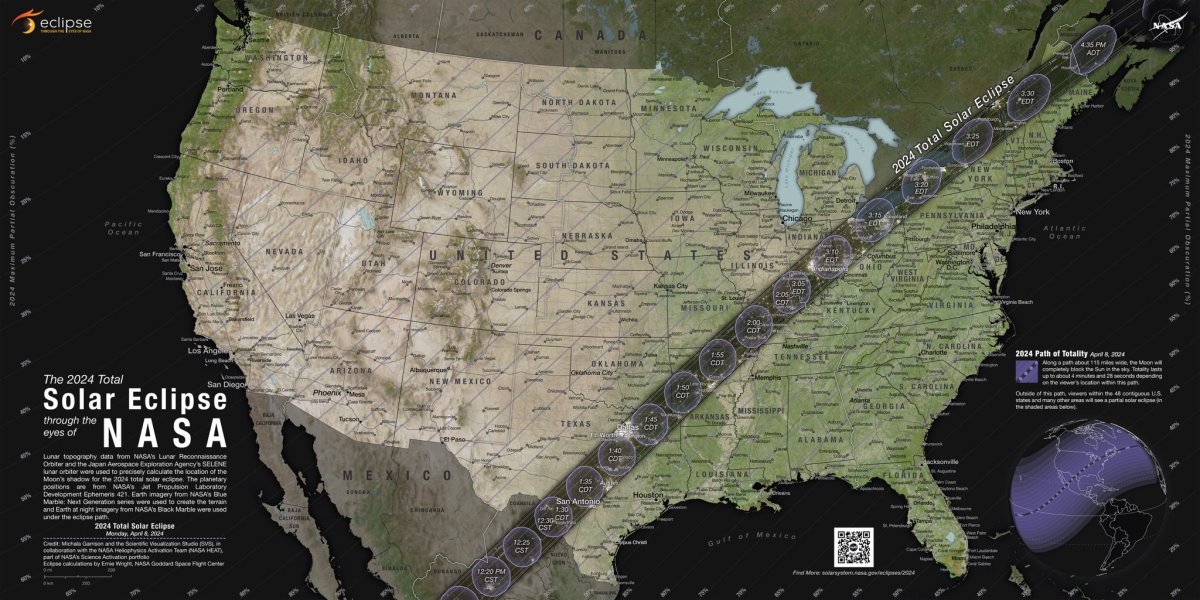A rare total solar eclipse will take place next month and will be the last chance for Americans to view the natural phenomena for two decades, astronomy experts have said.
A total eclipse will be experienced by millions of Americans on April 8 this year—a rare astronomical event in which the skies briefly turn dark during daylight hours. Next month's eclipse is a rare event, with the last one taking place over the U.S. in 2017.
"You definitely want to be looking at the sky on April 8th because if you miss the solar eclipse this year, you have to wait two decades until the next chance to see a total solar eclipse from the contiguous United States," Brian Lada, AccuWeather astronomy expert, told Newsweek.
"Total solar eclipses themselves are not rare. They happen every year somewhere around the world. What is rare is to have them visible here in the United States."
Total eclipses occur once every other year somewhere on the planet, but for each individual community, they occur once every few centuries with some exceptions, Lada explained.

What is a total solar eclipse?
According to Jonathan Belles, digital meteorologist for The Weather Channel, a solar eclipse takes place when the moon's orbit "takes it into the same plane as the sun, blocking out the sun."
There are numerous things to look out for - aside from the skies turning dark in the middle of the day - during a solar eclipse. Belles told Newsweek: "During a total solar eclipse, you can see explosions of matter being launched from the sun on some occasions. You'll likely see some eerie shadows in the form of eclipsed discs or even slithering snakes on the ground under trees and other objects. You might see bats and birds head out for food thinking that the sunset has arrived."
"If you look at the horizon, you may see thin clouds of ice that are usually invisible to the naked eye. You may also see clouds shrink over land or grow over the ocean. In elevated locations, you might also be able to tell where the sun is still shining."
Where can I see the total eclipse?

According to Lada, those wishing to catch a glimpse of the phenomenon will need to be "in a narrow area called the path of totality", stretching from Texas all the way to Maine in the northeast.
A NASA map shows the full trajectory of the eclipse across the states, including times it will occur on April 8. Starting in Texas at around 1:30 p.m. CDT, the eclipse will occur in Oklahoma, Arkansas, Missouri, Illinois, Kentucky, Indiana, Ohio, Pennsylvania, New York, Vermont, New Hampshire, and finally in Maine at 3:30 p.m. EDT. Small parts of Tennessee and Michigan may also experience the total solar eclipse.
"Everywhere outside of the path of totality will only experience a partial solar eclipse, of course, as long as it's not cloudy," Lada told Newsweek.

If you're planning to look skyward to see the event, you need to be prepared. NASA advises using the correct equipment to prevent causing serious damage to your eyes.
Read more: Best Credit Cards for Online Shopping
"When watching the partial phases of the solar eclipse directly with your eyes, which happens before and after totality, you must look through safe solar viewing glasses ("eclipse glasses") or a safe handheld solar viewer at all times," NASA explains. You can also use an indirect viewing method, such as a pinhole projector."
Uncommon Knowledge
Newsweek is committed to challenging conventional wisdom and finding connections in the search for common ground.
Newsweek is committed to challenging conventional wisdom and finding connections in the search for common ground.
About the writer
Aliss Higham is a Newsweek reporter based in Glasgow, Scotland. Her focus is reporting on issues across the U.S., including ... Read more
To read how Newsweek uses AI as a newsroom tool, Click here.








